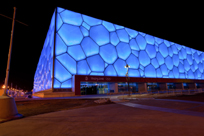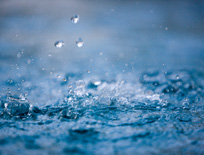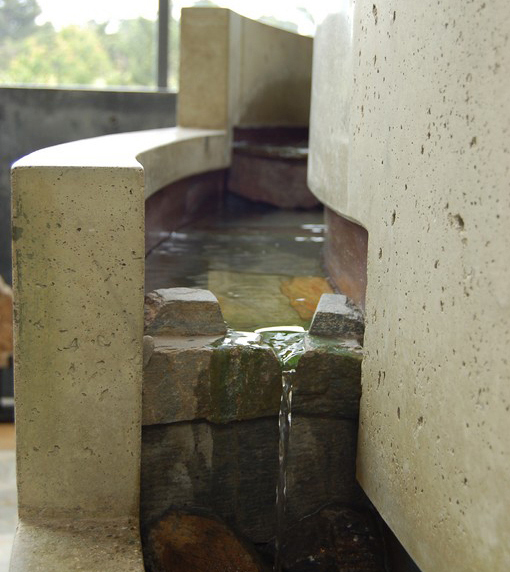Other Waterfeatures (from birdbaths to lakes)
Article: Learn more about the Beijing National Aquatics Center (the “Water Cube”) from Wikipedia. Click here. Video: Watch a CNN interview with
In addition to the aforementioned benefits from harvesting rainwater, Aquascape points out the following:“According to the EPA, storm water runoff is one of the main reasons
More than three years ago, I was approached by a talented landscape architect (and good friend) to look at project with an interesting twist: the celebration of the agricultural history of a well-known California city. I’ve long been fascinated by history and have taught the history of art and architecture in a variety of settings, so when Lance Walker (then principal at The Collaborative West, San Clemente, Calif.) called me, I was keenly motivated to hear more about his plan to pay homage to those who had jump-started a major modern community by harnessing a natural watercourse to
By Fu-Tung Cheng I’ve never been entirely comfortable with the term “decorative concrete.” To me, the pairing of the words has always implied that one merely applies material over a substrate in the way a baker might apply icing to decorate a cake. Instead, I see concrete as inherently profound. More than appliqué, it is a medium that has long been used functionally as well as expressively. In my own case, I feel far more creatively engaged in my work when I merge my thinking about those dual potentials of function and art. Historically, in fact, I believe that when the two become an inseparable one, we recognize and celebrate these works as rising to the level of great design. In my own case, I began using concrete as an expressive medium a few decades back, when I was among the pioneers in designing and installing concrete countertops in contemporary kitchens. As both designer and builder, by the year 2000 I had
Marine and zoological exhibits have always presented watershapers with a variety of specific technical challenges, not the least of which is devising a waterproofing system that will keep these vessels watertight, the viewing areas dry and the animal life safe. Here, Michael Mudrick and Elena Danke of Aquafin discuss a variety of lessons to be learned in pursuing these projects – and how they apply to other watershapes as well. Designing, engineering and installing watershapes for zoological and aquarium applications is never a casual exercise, especially when it comes to waterproofing. Not only do you have to find a product or combination of products that can accommodate various structural penetrations, adhere to all of the materials being used and, quite often, conform to irregularly shaped surfaces: Whatever material or system you select must also
In January 2008, southern California’s Orange County Water District unveiled its Groundwater Replenishment System, a treatment and reuse facility dedicated to producing water to resupply the county’s beleaguered groundwater reserves. A year later, Eric Herman toured the facility, getting a behind-the-scenes look at a thought-provoking system that is setting new standards for water treatment, management and use. While I was preparing our “True Green” issue for publication last summer, a friend invited me to tour the Groundwater Replenishment System, an advanced, 70-million-gallon-per-day water-purification facility located in Fountain Valley, Calif. The invitation to visit this joint project of the Orange County Water District and the Orange County Sanitation District came through
I was out of a job in Gloucester, England, several years back when I came across a collection of wonderfully unusual sculptures that changed my life. These compositions, called Flowforms, were the work of British sculptor John Wilkes, an inspired artist who for most of his professional life has explored ways to use water’s nature and characteristics as his medium. I was immediately drawn to what I saw: I’d worked as an estate gardener before being trained as a sculptor at the St. Martin School of Art in London and had always had an interest in natural forms and all sorts of experimental media. I had also spent a good part of
There may still be some who resist the idea, but by now it is verifiable fact that plant material can be used to treat and purify water in artificial watershapes as well as in natural bodies of water. For decades, in fact, scientists have borne witness to these processes in natural wetlands – so much so that today, these concepts are being studied around the world using artificial wetlands and floating islands that mimic natural structures and processes. Our firm, Floating Island International of Shepherd, Mont., is predictably focused on the floating island concept. In our efforts to understand all of the nuances and specifics of how plants on floating islands can be used to best advantage, we have made contact and worked worldwide with scores of independent researchers and institutions across a range of settings, applications and agendas. Yes, we’ve been gratified by the resulting findings and the benefits that reportedly flow from use of our systems. In a more important and greater context, however, we see this collection of empirical data and anecdotal evidence as conclusive proof that biological water treatment is not only viable, but is also surprisingly
Among the wonderful benefits of working in the custom watershaping business is that you never really know what sort of projects will wander into view. Through the years, we at Live Water Creations of Santa Rosa, Calif., have certainly participated in developing and executing some unusual designs, but I can honestly say that working on one that included a huge, beautiful steel pyramid topped by a deep-space telescope was something that had yet to come our way. And it would have stayed that way had I not received a call from John Anderson of Pools by Rapp, another firm here in Santa Rosa. We’ve collaborated on other projects in which our firm has built ponds or fountains to go along with pools and spas he’s done. In this case, he was installing a lap pool and wanted our help in what he could only describe as an extremely unusual watershape. The client said he had just built a beautiful contemporary home and, as an astronomy buff, wanted to complete the package with
Wanting to soften and humanize the austere appearance of a new facility for homeless families, the benefactors of the Orange County Rescue Mission in Tustin, Calif., commissioned an unusual watershape. The idea pulled watershaper Mark Holden and project manager Jim Bucklin into a whirlwind in which they had to create unique systems to accommodate the world’s largest ceramic amphora – and do so within an extraordinarily tight deadline. What happens when one of the country’s wealthiest philanthropists provides funding for a truly unique art piece in support of a favorite cause? The short answer is, everyone jumps to make it happen. That was literally the situation when a nonprofit organization that serves the needs of homeless families received a donation from its largest benefactor to fund construction of an unusual fountain system. The waterfeature, we learned, was to support the world’s largest amphora, which at that time was just being completed by a Danish artist. Destined for the courtyard of a new facility about to be






















